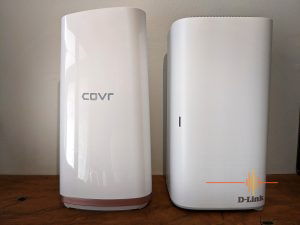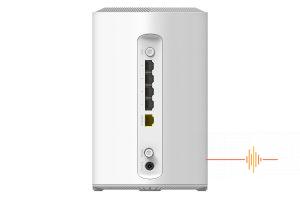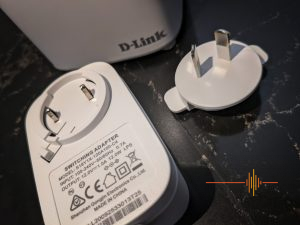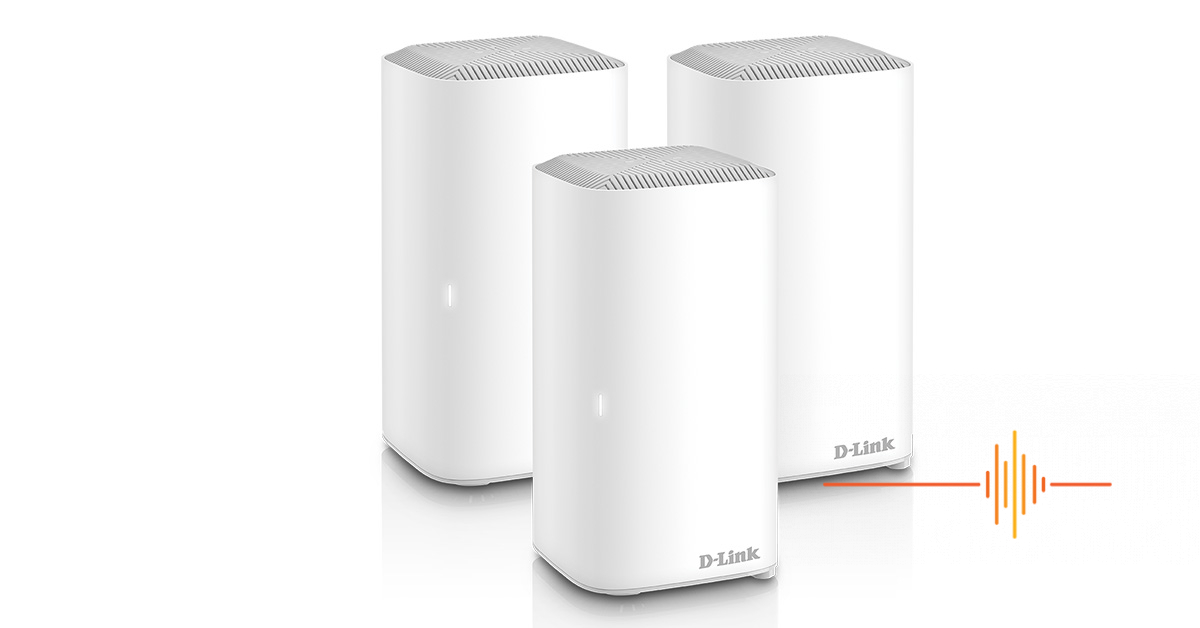A new year and an upgraded mesh system from D-Link. The D-Link AX1800 has all the latest advancements including dual band mesh, Wi-Fi 6 and WPA3 for starters.
I have been using the COVR 2202 as my network backbone for most of 2020. It has been a solid piece of kit although there were definitely limitations and issues that I have noted at the time. I lived with it and the world kept spinning.
 First Impressions
First Impressions
Upon receiving the review unit, a number of things are immediately apparent. To be fair, these changes were already in place with the COVR-11XX series that was launched after the COVR-2202.
From an aesthetics point of view, the nodes are now white monoliths instead of the a gloss white triangular tower with rose gold trim. The footprint is roughly on par with each other.
There is no longer a COVR Point “A” node that must be be the one to be connected to the WAN port. Actually there is no such thing as COVR Point A anymore.
Instead of the COVR logo lighting up to indicate the status of the device and network, there is just a discreet white LED on the corner.
Weight wise it is night and day. The COVR AX is significantly lighter than the previous flagship model.
Whereas previously the COVR-2202 is a two node affair, the COVR AX comes in single, twins and triplets packs.
D-Link has addressed one of my biggest gripes with the COVR-2202 series, the COVR AX now comes with 4 Gigabit LAN ports per node.
 Configuration
Configuration
To begin my review, I swapped out my existing COVR infrastructure like-for-like. So whilst I have a 3-node kit for review, I started with only two nodes and I have them in the same spots as I have for the past year.
The D-Link app on the smartphone allows you to quickly setup the units. The same limitations still applies where it only allows you to set up the basics such as main and guest WiFi networks. It does let you throw in a custom DNS server if you have a particular choice other than your ISP default. There are certainly good reasons to do so, check out OpenDNS, CloudFlare and Google for options.
For those with a need to implement Parental Control, it is no longer a separate app (D-Link Defender) as it was with the COVR-2202. This can all be done in the D-Link WiFi app now.
For more advanced configuration such as subnet changes, firewall rules and VPN configuration, one has to head over to the WebUI to get the job done.
In Use
With the COVR-2202, I had little in the way of complains about coverage. Naturally due to the material used in construction there were some spots where the signal was lower than others. I did not have a particular need to blanket cover my entire property with WiFi coverage, like, I wouldn’t ever sit on the back fence and do my work. But with the COVR AX node I found that without doing anything in particular, the overall area of coverage is quite a bit better.
Also unlike the older version, the COVR AX supports an ethernet backhaul to the secondary nodes.
The increase of gigabit ports from 2 to 4 is a welcome addition. With the COVR-2202 I was constrained by a maximum of three network ports across 2 nodes. In my configuration, on Node A one port is consumed by the WAN port, and the second was consumed by a LAN connection back to the Ubiquiti switch. Anything else that needed to be hardwired have to be handed off to the second node which meant my Arlo base station had to be shifted closer to the mesh node.
With this upgrade, my Arlo base station can go back to a spot more central in the house where I have always planned for it to be. It also eases up my restrictions on hardwired equipment. Although the WiFi bandwidth increased in leaps and bounds, sometimes it is still nice to have a LAN connection. For example my TV does not have WiFi 6 and it is unlikely to be replaced any time soon, a LAN connection will ensure the best performance for streaming.
Other Features
The AC adapter features a removable plug. This is particularly handy if you need to have the orientation of the brick reverse if you need to work with the space on your socket.
Parental Control is now integrated into the same WebUI and the D-Link WiFi app. It was one of my bugbears that it was a completely separate app previously and was clunky to use. With this version, Parental Control is easily done with the following in a profile:
- Schedule (online schedule)
- Bedtime schedule
- Website Filter
- Device Filter
In my testing, this has worked well for both scheduling and site filter. When the profile is active, internet requests are returned with a site unreachable error.
I noted in the COVR-2202 review, that the McAfee integration brings back an SSL error which is quite confusing for the average user. This is certainly an improvement.
There is a single button to pause internet for all clients.
 Like all of the recent crops of D-Link devices, there is Alexa and Google integration. Personally I find that I don’t use this feature because it does not suit my needs. The COVR AX supports the following commands, with either the “Alexa” or “OK Google” prefix:
Like all of the recent crops of D-Link devices, there is Alexa and Google integration. Personally I find that I don’t use this feature because it does not suit my needs. The COVR AX supports the following commands, with either the “Alexa” or “OK Google” prefix:
- “[prefix], talk to D-Link Wi-Fi to turn on guest Wi-Fi”
- “[prefix], talk to D-Link Wi-Fi to tell me my guest Wi-Fi credentials”
- “[prefix], talk to D-Link Wi-Fi to reboot my router”
- “[prefix], talk to D-Link Wi-Fi to upgrade my firmware”
Gripes
I think I have banged on this point on every D-Link review in recent times. I just wish that the app and WebUI can offer the same functionality.
App only
- D-Link Cloud Registration
WebUI only
- QoS Engine
- Firewall
- Port Forwarding
- Static Routes
- Dynamic DNS
- QuickVPN
- Troubleshooting logs
There is no ability to export the configuration from the previous hardware for import with the new one. Not a big drama for your average user, but I have specific rules in place in my configuration which had to be manually added again. Also adding human friendly labels back to a fair number of DHCP clients was time consuming. It would have been nice to be able to export to XML rather than the standard config.bin, but this is hardly an issue limited to D-Link and home grade devices.
There is no category filtering for Parental Control. Filters is via URL/domain and there is a limit of 24 entries.
Conclusions
Whilst I am unable to take full advantage of the WiFi 6 capabilities of the COVR AX, the upgrade has still given me some significant gains. The 4 Gigabit Ethernet ports are a welcome sight, and Parental Control is much simpler to do although it is also a little more limited in function.
The improvements in WiFi coverage is definitely much appreciated. I can get away with using only 2 mesh nodes with the COVR AX, although the third just means I certainly never have to wonder about if I have strong enough WiFi signal everywhere at my place.
The D-Link COVR AX is available from D-Link Australia in single (AUD$249.95), twins (AUD$399.95) and triplet packs (AUD$549.95). It is will also be available at Amazon and buying through Amazon helps DigitalReviews so we appreciate you considering making your purchase there.
DRN would like to thank D-Link for their on-going support.
Feature Highlights
- Wi-Fi 6 technology provides faster speeds, greater capacity and less network congestion
- Speeds up to 1.8 Gbps (574 + 1200) built for the modern device-dense smart home
- Coverage up to 740 sqm
- 4 Gigabit Ethernet LAN ports provide optional wired connectivity (per unit)
- D-Link Wi-Fi Mesh offers one unified network experience that auto connects you to the strongest signal
- OFDMA and MU-MIMO technology communicate more data to more devices while simultaneously reducing latency
- BSS colouring helps organise data packets, making your network more efficient and improving Wi-Fi 6 performance
- Increased battery life of connected devices with Target Wake Time (TWT) technology
- Supports the latest WPA3 encryption
- Built-in Speedtest powered by Ookla
- Voice Control for an even easier home Wi-Fi networking experience
Specifications
Wi-Fi Speed : AX1800 (574 + 1200Mbps)
Warranty : 3-Year Limited Warranty
NBN/UFB Support : FTTP / FTTC/ HFC / Satellite / Fixed Wireless
Ethernet Ports : 4
Guest Network : Yes
Parental Controls : Yes|Schedule
Wireless Bands : Dual Band
WAN Interface : Gigabit Ethernet
Wave 2 MU-MIMO Wi-Fi : Yes
Mesh Standard : COVR Series
Wi-Fi Technology : Wi-Fi 6 (802.11ax)
Smart Home Compatible : Amazon Alexa|Google Assistant
Internet Protocols : IPv4|IPv6
Wi-Fi Security : WPS|WPA/WPA2-Personal|WPA3-Personal
Firmware Upgrade : Yes|OTA Firmware Upgrade
SpeedTest Powered : Yes
App Support : D-Link Wi-Fi
















